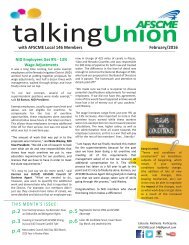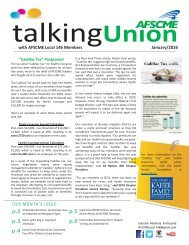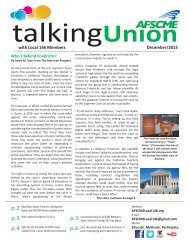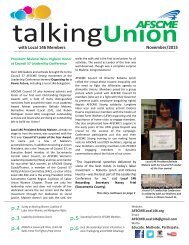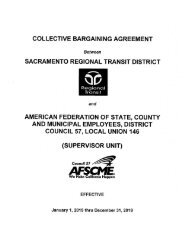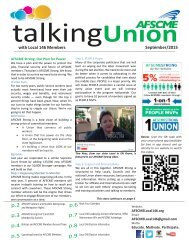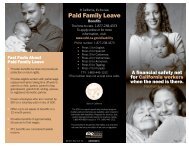STEWARD HANDBOOK
Create successful ePaper yourself
Turn your PDF publications into a flip-book with our unique Google optimized e-Paper software.
AFSCME Retirees<br />
Nearly 250,000 women and men belong to AFSCME Retirees, a nationwide<br />
program that enables them to fight effectively for common goals such as preserving<br />
Social Security and improved retirement benefits.<br />
Child Care Providers Together<br />
Child Care Providers Together (CCPT) was founded and is run by homebased<br />
child care providers, who believe every child deserves the best early<br />
care and education. By joining together in CCPT, providers gain more control<br />
over their work, access to benefits and greater respect as professionals.<br />
AFSCME: Decades of Fighting for Worker Rights<br />
In 1932, as the country suffered through a severe economic depression, a<br />
small group of white-collar professional state employees met in Madison,<br />
Wis., and formed what would later become Wisconsin State Employees<br />
Union Council 24. The reason for the group’s creation was simple: basic<br />
survival. State employees feared that politicians would implement a political<br />
patronage system and thousands of workers would lose their jobs. Meetings<br />
were held, marches and demonstrations were organized, and this first movement<br />
of public-sector workers saved their jobs and gave birth to a union.<br />
By 1935, similar state employee associations emerged in 19 states,<br />
fighting for job security, decent pensions and health insurance for public<br />
workers. In 1936 the group – which changed its name to the American<br />
Federation of State, County and Municipal Employees – was granted a<br />
charter by the American Federation of Labor (AFL). The union of 10,000<br />
members chose Arnold Zander as its first national president.<br />
Two years later, in 1938, 2,000 garbage collectors in Philadelphia went<br />
on strike to protest layoffs and pay cuts, and four days later they won the<br />
union’s first bargaining agreement with a major city. Workers in other<br />
urban areas began organizing, increasing AFSCME’s membership among<br />
blue-collar workers with strong trade union roots and traditions. Twenty<br />
years after the creation of AFSCME, the union had 200,000 members and<br />
a battle on its hands with the entrenched power structure of America’s<br />
major cities.<br />
The movement to build power for public employees got a major boost in<br />
1958 when President Jerry Wurf of District Council 37 led a series of strikes<br />
and demonstrations that forced the mayor of New York City to negotiate<br />
with the unions representing city employees. A turning point was reached.<br />
55



